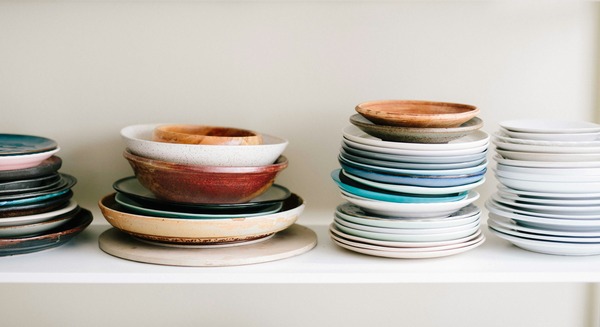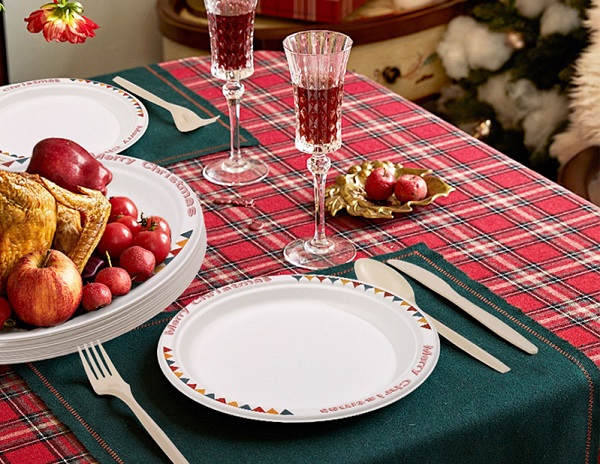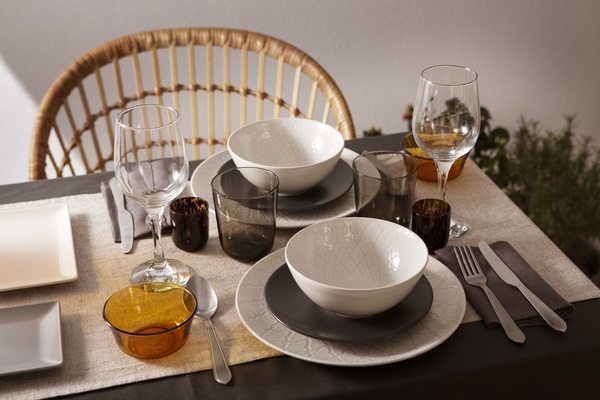Welcome to Sumkoka
English
- All
- Product Name
- Product Keyword
- Product Model
- Product Summary
- Product Description
- Multi Field Search
Views: 0 Author: Site Editor Publish Time: 2025-10-27 Origin: Site








Choosing non-toxic dinnerware helps your customers stay safe and actually eat healthy. You have probably seen a BPA free symbol on certain products. Some dinnerware products also have a PFAS free or PFOA-free label. But what do these labels mean? What’s their purpose?
Are PFAS free pans better for your customers, or must they get a BPA-free bowl to serve food? This blog will compare PFAS-free cookware and BPA-free tableware to determine which one is better. What is the safest dinnerware? As a businessperson, you need to understand these labels so you can better guide your customers and explain to them what these labels mean.

News was circulating online recently that the top European baby pacifier brands contained cancer-causing chemicals like BPA. That’s why many parents started investing in BPA-free water bottles and toys. So, what does BPA free mean? The label "BPA free" means that your resin/plastic dinnerware doesn't contain bisphenol A, which is a synthetic chemical used in the making of polycarbonate plastics and polymer materials (i.e., not healthy for consumption).
BPA free plastic products don't contain this chemical. This chemical is heat-resistant and offers immense durability. But it also leaches into food and beverages when you heat/scratch it (yeah, even scratching it makes it dangerous for you). It's an endocrine disruptor, so it interferes with your hormone function. If you don't use BPA free storage containers, you may experience:
Reproductive issues
Developmental problems
Metabolic disorders
Increased risk of certain cancers.
Next, we come to the next of PFAS. If you’ve ever sold a PFAS free rice cooker, PFAS free non stick pans, or something else, you probably wondered what this label means. Well, this label means that your products don’t have per- and polyfluoroalkyl substances (PFAS), a large family of man-made chemicals known for their strong carbon-fluorine bonds. These substances are hydrophobic and heat-resistant. Your non-stick cookware probably contains them, too.
They also resist oils and stains. So, they are used in greaseproof food packaging or firefighting foams. They also go by the label of “forever chemicals,” so a PSAF-free product simply doesn’t contain them. PFAS are bad for the environment. They aren’t biodegradable and cause chronic health issues like thyroid disorders, immune system suppression, elevated cholesterol, etc.
Are you on a quest to find the safest dinnerware brands? You’re probably asking: “What is the safest material for dinnerware?” We’ll help you find the best material for dinnerware. Whether you're planning to order PFAS free cookware or BPA free plastic water bottles, use this guide to compare the two food packaging symbols and determine which one your customers want.
Chemical Persistence: PFAS are really persistent; they practically live forever and don’t break down easily in the environment. They accumulate in soil, water, and even people & animals. That’s how they cause long-term contamination problems that are difficult to reverse. BPA also leaches into food and water, but it’s not that persistent. It degrades under certain conditions.
Health Risks: Both BPA and PFAS are endocrine disruptors. It means that they interfere with hormonal functions. But PFAS exposure is very severe; it leads to cancers, immune system suppression, thyroid disease, etc. BPA's main concern centers on reproductive & developmental issues. PFAS can also bioaccumulate in your body over time.
Common Uses: You get BPA mainly in polycarbonate plastics and epoxy resins; BPA is used to make water bottles, plastic containers, metal can linings, etc. On the other hand, PFAS has its uses in non-stick cookware coatings, grease-resistant food packaging, and stain-resistant fabrics. We can say that PFAS have a more widespread presence.
Consumer Labels: The need for safe dinnerware and nontoxic dishes is universal. That is why BPA has been restricted or banned in many products, especially those for infants. PFAS are facing more stringent global restrictions due to their environmental persistence & toxicity. Labels like “BPA-free” and “PFAS-free” address different classes of chemicals, so seeing both is ideal for minimizing exposure. Moreover, vintage bowls and plates tend to contain toxic chemicals that make them unsafe for everyday use.
BPA | PFAS | |
Type | Single synthetic compound | Large group of fluorinated compounds |
Persistence | Moderate (can degrade over time) | Extreme persistent (called the “forever chemicals) |
Health Hazards | Reproductive, developmental, and metabolic disorder risks | Immune suppression, cancer, thyroid issues, etc. |
Common Uses | Plastics and epoxy linings | Non-stick cookware and grease-resistant packaging |
Bioaccumulation | Minimal to moderate | High (long-term accumulation) |
Regulatory Status | Banned/restricted in baby products | Increasing bans and scrutiny globally |

When it comes to choosing the best dinnerware material for your customers, the choice is just between these two options: PFAS-free items can be the safest dishes, but BPA-free ones also claim the title of healthy dinnerware. If you want the best dinner plates in the world, follow these simple tips. These tips will explain how to choose BPA-free & PFAS-free tableware:
You should check that your manufacturers are equipped with these certifications.
GreenScreen Certified™ for Food Service Ware: This one indicates that no PFAS or thousands of other harmful chemicals are intentionally used. Developed by the Center for Environmental Health and Clean Production Action, this certification ensures strict chemical safety standards.
NSF 537 PFAS-Free Certification: This one’s a new global certification that verifies the absence of PFAS in food-contact products through rigorous ingredient review & annual testing.
BPI (Biodegradable Products Institute) Certification: This certification signals either the absence or safe levels of concerning chemicals like BPA/PFAS.
FDA Food Contact Compliance: Make sure that the materials you are ordering in bulk meet US safety standards for food contact. This includes limits of BPA and fluorinated substances.
If you want to sell nontoxic items, consider getting dinnerware made of these materials:
Bagasse Tableware: Bagasse materials give you peace of mind. These materials are made from sugarcane fiber. They naturally contain no BPA or PFAS. This material is also compostable and highly sustainable.
Glass/Ceramic Tableware: If this option is free from harmful glazes or coatings, then it is both BPA-free and PFAS-free. You may use it in your house as well.
Stainless Steel: If you need something durable and chemical-free, put your faith in the good ol'stainless steel. This material is great for reusable dinnerware. Also, it’s 100% safe for children.
Silicone: Food-grade silicone is another option that doesn't contain BPA/PFAS. You also get heat resistance and durability from these materials.
You should always read labels carefully by:
Looking explicitly for “BPA-free” and “PFAS-free” claims supported by certifications
Watching out for vague marketing terms like “non-toxic” or “eco-friendly” without actual substantiation
Avoiding manufacturers supplying transparent ingredient lists (third-party test results are preferable)
Disposable items should be compostable and certified free of these dangerous chemicals. Reusable tableware selected for BPA and PFAS absence reduces repeated exposure.
Choose brands known for sustainable, chemical-safe production. Avoid companies that use recycled materials without PFAS/BPA testing or that don’t disclose chemical safety practices.
In the end, you should contact trusted retailers who vet their products for safety certifications. Look for labels and product info on their packaging. Consult their online listings. That’s how you can see which materials are the safest for dinnerware to be sold to your consumers.
Reusable or Disposable? | BPA-Free? | PFAS-Free? | |
Plastic (polycarbonate, polystyrene) | Both | No | No |
Sugarcane Pulp (Bagasse) | Disposable | Yes | Yes |
Wheat Straw | Disposable | Yes | Yes |
Cornstarch | Disposable | Yes | Yes |
Glass | Reusable | Yes | Yes |
Ceramic/Porcelain | Reusable | Yes | Usually |
Stainless Steel | Reusable | Yes | Yes |
Bamboo | Both | Yes | Usually |
Silicone | Reusable | Yes | Yes |

Many industries are looking for safe materials for dinnerware. Foodservice businesses comply with banning PFAS and BPA in packaging & disposable dinnerware to meet these demands. In food distribution, we notice how producers make sure that packaging and containers meet local safety standards. So, let’s talk about non toxic dinnerware policies in different parts of the world.
The EU has taken strict measures against these toxins with Regulation 2024/3190. Countries in Europe have banned BPA in food-contact materials like plastics, varnishes, adhesives, printing inks, etc. These policies became effective on January 20, 2025. This regulation includes phased transitional periods that allow affected businesses time to comply.
Also, the EU's Packaging and Packaging Waste Regulation (PPWR) will prohibit placing objects containing PFAS on the market from August 2026. This soon-to-be-active regulation will target single-use food contact packaging. The EU's tight regulations urge food service providers and distributors to switch to BPA- and PFAS-free alternatives promptly.
India's Food Safety and Standards (FSSAI) has proposed some amendments in October of this year that prohibit the use of BPA/PFAS in food contact materials. This draft rule signals India’s commitment to global safety norms. It seeks compliance across food packaging manufacturers and users. So, hotels and restaurants in India must procure the safest dishware in the world.
These two countries don’t have comprehensive bans on BPA/PFAS right now. However, they do maintain regulatory limits on BPA exposure. Australia’s Food Standards (FSANZ) monitors BPA levels and other chemicals in dinnerware. That’s how it meets consumer safety standards while gradually phasing out these health-risking chemicals. Australia and New Zealand are observing international trends and are likely to strengthen future policies on these chemicals.
Various states and municipalities have enacted bans or restrictions on BPA in baby bottles and children’s food packaging. PFAS regulations are evolving rapidly at the state and federal levels, with some states banning PFAS in food packaging & urging companies in the foodservice, retail, and hospitality sectors to adopt safer alternatives.
Toxic Chemicals | Common Uses | Health Hazards |
Phthalates | Plasticizers that make plastics more flexible | Disrupts hormone function and causes reproductive issues |
Lead and Cadmium | Found in ceramic/glazed dinnerware | Toxic to ingest and can cause kidney or brain damage |
Melamine | Plastic dinnerware (the cheap & low-quality type) | Release toxic compounds upon heating |
Formaldehyde | Used in paper and cardboard packaging | irritates the respiratory system and may have carcinogenic effects as well |
Toluene and Xylene | Used in inks and dyes on food packaging as solvents | Migrates into food and poses a serious risk to your nervous system |
Nonylphenol | Manufacturing plastics and detergents | Accumulates in the environment & humans |
Styrene | Present in some foam containers | A possible carcinogen linked to blood disorders |
Choosing BPA- and PFAS-free dinnerware isn’t about safety; it’s about committing to a healthier lifestyle and a cleaner planet. Getting the healthiest dinnerware becomes possible when you’ve understood what these labels mean. Whether you need safe dishes or safe plates, contact only a decent nontoxic dinnerware manufacturer. Order chemical free dinnerware in bulk from China.
Ready to upgrade your tableware with trusted, eco-friendly products? Discover the right solution for your business with Sumkoka’s certified compostable bagasse tableware. Explore our core advantages, request free samples, and see why thousands trust Sumkoka for superior quality and safety. Visit our website to learn more about our eco-friendly dinnerware options and take a confident step toward sustainability. The safest non toxic dinnerware is available right here!
1. Are BPA-free products always safe?
Not necessarily. BPA-free means no bisphenol A, but other harmful chemicals may be present. Look for products tested and certified free of other toxins like phthalates or PFAS.
2. How can I tell if dinnerware is PFAS-free?
Check for clear “PFAS-free” labeling and certifications such as NSF 537. Ask manufacturers for test results or product safety documentation.
3. Can plastic dinnerware be truly non-toxic?
Some plastics labeled BPA-free and made from safer materials can be low risk, but plastics can still leach chemicals when heated. That’s why you must opt for glass, stainless steel, or certified compostables for safety.
4. Are disposable, eco-friendly options free from harmful chemicals?
Materials like bagasse (sugarcane pulp), wheat straw, and cornstarch are naturally free from BPA and PFAS and are compostable, making them safer disposable choices.
Sumkoka's product range includes sugarcane pulp plates, flip-top containers, soup bowls, and tableware sets. Our products contain no harmful chemicals and are biodegradable. With over 20 years of manufacturing experience, our biodegradable tableware distributed to overseas businesses has earned widespread acclaim.
Contact us now to request samples for testing!